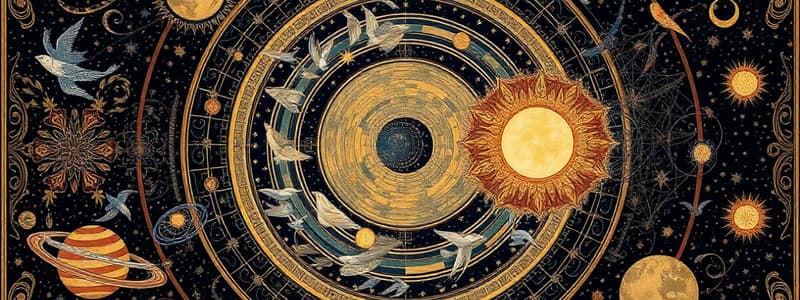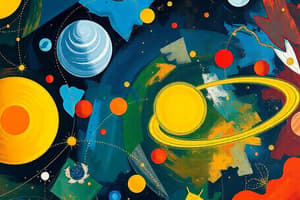Podcast
Questions and Answers
Moons orbit the sun, whereas planets orbit other planets.
Moons orbit the sun, whereas planets orbit other planets.
False (B)
Asteroids are exclusively composed of rock materials.
Asteroids are exclusively composed of rock materials.
False (B)
Comets typically develop a water tail as they approach the sun.
Comets typically develop a water tail as they approach the sun.
False (B)
A meteor transforms into a meteorite after completely disintegrating in Earth's atmosphere.
A meteor transforms into a meteorite after completely disintegrating in Earth's atmosphere.
In our solar system, Venus is the planet positioned closest to the sun.
In our solar system, Venus is the planet positioned closest to the sun.
Jovian planets are characterized by having a solid surface and a metal core.
Jovian planets are characterized by having a solid surface and a metal core.
Plate tectonics is propelled by radiation currents originating from the Earth's core.
Plate tectonics is propelled by radiation currents originating from the Earth's core.
The Sun's core, where nuclear fusion occurs, has a temperature of approximately 27 million degrees Fahrenheit.
The Sun's core, where nuclear fusion occurs, has a temperature of approximately 27 million degrees Fahrenheit.
The Sun is the hottest known object in the Milky Way galaxy.
The Sun is the hottest known object in the Milky Way galaxy.
The Sun's outermost layer, the Corona, has a consistent temperature throughout.
The Sun's outermost layer, the Corona, has a consistent temperature throughout.
The process of photons bouncing around within the Sun's radiative zone takes thousands of years.
The process of photons bouncing around within the Sun's radiative zone takes thousands of years.
The layer of the Sun visible from Earth is the Chromosphere.
The layer of the Sun visible from Earth is the Chromosphere.
Sunspots form in the Sun's corona due to fluctuations in magnetic fields.
Sunspots form in the Sun's corona due to fluctuations in magnetic fields.
The Sun is approximately 93 million miles from Earth.
The Sun is approximately 93 million miles from Earth.
A celestial body must orbit a star and have enough gravitational pull to maintain a spherical shape to be classified as a planet.
A celestial body must orbit a star and have enough gravitational pull to maintain a spherical shape to be classified as a planet.
Flashcards
Sun
Sun
The central star of our solar system, a medium-sized yellow star.
Nebula
Nebula
A mass of gas and dust where stars, including the Sun, form.
Core
Core
The hottest part of the Sun where nuclear fusion occurs; temperature is 27 million °F.
Radiative Zone
Radiative Zone
Signup and view all the flashcards
Photosphere
Photosphere
Signup and view all the flashcards
Sunspots
Sunspots
Signup and view all the flashcards
Solar System
Solar System
Signup and view all the flashcards
Distance from Earth to Sun
Distance from Earth to Sun
Signup and view all the flashcards
Moons
Moons
Signup and view all the flashcards
Asteroids
Asteroids
Signup and view all the flashcards
Comets
Comets
Signup and view all the flashcards
Meteoroids
Meteoroids
Signup and view all the flashcards
Meteors
Meteors
Signup and view all the flashcards
Meteorites
Meteorites
Signup and view all the flashcards
Plate Tectonics
Plate Tectonics
Signup and view all the flashcards
Study Notes
The Sun
- The Sun is a middle-aged, yellow star at the center of our solar system.
- It's a ball of superheated ionized gases (plasma).
- It formed in a nebula about 4.5 billion years ago.
- The Sun has six layers with varying temperatures.
Sun's Layers
- Core: Hottest part (27 million °F/15 million °C), site of nuclear fusion.
- Radiative Zone: Photons travel thousands of years, absorbed and emitted by particles (12 million to 4 million °F/7 million to 2 million °C).
- Convection Zone: Heat moves outward in large cells (4 million °F/2 million °C).
- Photosphere: Visible surface (10,500 °F/5,800 °C).
- Chromosphere: Sun's atmosphere (11,000°F to 36,000°F/6,000°C to 20,000°C).
- Corona: Millions of km wide, outermost layer (1.8 million °F/1 million °C).
Sun Facts
- Not the hottest star in the galaxy (Neutron stars are hotter).
- Sunspots are linked to magnetic field changes in the convective layer.
- 93 million miles (150 million kilometers) from Earth.
- Earth's distance allows liquid water, supporting life.
- Sunlight takes about 8 minutes to reach Earth.
Celestial Bodies
- Planets: Must have enough gravity to form a sphere and clear its orbit. Orbit a star.
- Moons: Similar to planets in shape, orbit planets, not stars.
- Asteroids: Made of metal, rock, or both. Considered minor planets or planetoids.
- Comets: Small, icy bodies (frozen gases, rocks, dust). Orbit stars in elliptical paths, developing gas tails near stars.
- Meteoroids: Float in space, made of various materials.
- Meteors: Meteoroids entering Earth's atmosphere, heated by friction, often disintegrate.
- Meteorites: Meteors that reach Earth's surface.
Planets of our Solar System
- Eight planets orbit the Sun, including: Mercury, Venus, Earth, Mars (terrestrial), Jupiter, Saturn, Uranus, Neptune (Jovian/gas giants).
- Terrestrial planets: Solid surfaces, smaller, metal cores (Mercury, Venus, Earth, Mars).
- Jovian planets: No solid surface, mostly gases (Jupiter, Saturn, Uranus, Neptune).
Landforms
- Landforms: naturally occurring physical features on Earth.
- Geomorphologists study how Earth's surface changes over time (plate tectonics, volcanic activity, erosion, etc).
- Land types: coast, island, peninsula, bay, mountain, hill, plateau, valley, canyon, plains. Ocean basins also contain landforms (abyssal plains, seamounts, trenches, volcanic islands).
Plate Tectonics
- Plate tectonics theory explains Earth's plate movement and changes.
- Driven by convection currents in the mantle, heated by the Earth's core.
- Supported by modern measurement technology.
Studying That Suits You
Use AI to generate personalized quizzes and flashcards to suit your learning preferences.





